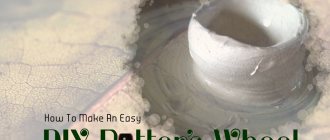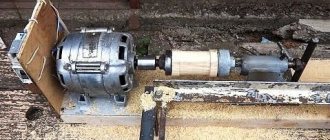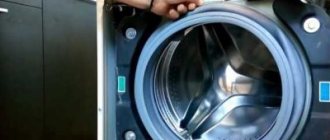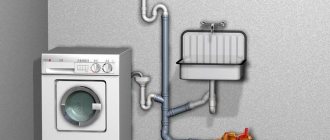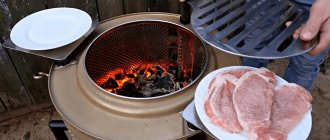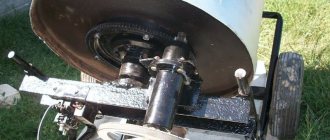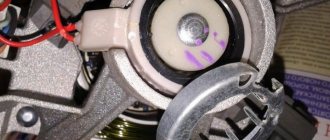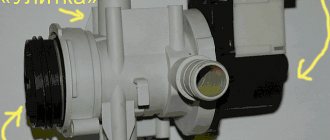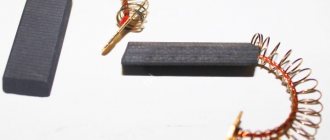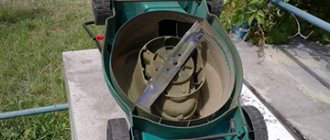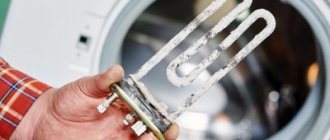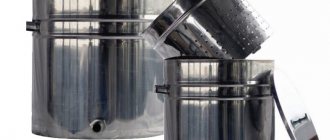Have you long wanted to install an alternative energy source? A significant obstacle to the implementation of the idea is the cost of the device. But don’t despair, you can make a wind generator from a washing machine engine with your own hands.
This mechanism will convert wind power into electrical energy, and you will use it for everyday needs. To create a device yourself, read our article.
Calculating the power of the future wind generator
First, you should find out what power a wind generator should have with your own hands, what are the functions and loads that it will face.
As a rule, alternative sources of electricity are used as auxiliary ones, that is, intended to assist the main power supply. Therefore, if the system power is even 500 watts or more, this is already quite good. At the same time, the final power of a wind generator depends on other factors, including:
- wind speed;
- number of blades.
To find out the appropriate ratio for horizontal type devices, we recommend that you familiarize yourself with the table below. The numbers in it at the intersection are the required power (indicated in watts).
Table. Calculation of the required power for horizontal wind generators.
| 1m | 3 | 8 | 15 | 27 | 42 | 63 | 90 | 122 | 143 |
| 2m | 13 | 31 | 63 | 107 | 168 | 250 | 357 | 490 | 650 |
| 3m | 30 | 71 | 137 | 236 | 376 | 564 | 804 | 1102 | 1467 |
| 4m | 53 | 128 | 245 | 423 | 672 | 1000 | 1423 | 1960 | 2600 |
| 5m | 83 | 166 | 383 | 662 | 1050 | 1570 | 2233 | 3063 | 4076 |
| 6m | 120 | 283 | 551 | 953 | 1513 | 2258 | 3215 | 4410 | 5866 |
| 7m | 162 | 384 | 750 | 1300 | 2060 | 3070 | 4310 | 6000 | 8000 |
| 8m | 212 | 502 | 980 | 1693 | 2689 | 4014 | 5715 | 7840 | 10435 |
| 9m | 268 | 653 | 1240 | 2140 | 3403 | 5080 | 7230 | 9923 | 13207 |
For example, if in your region the wind speed is predominantly from 5 to 8 meters per second, and the required wind generator power is 1.5-2 kilowatts, then the diameter of the structure should be approximately 6 meters or more.
General assembly
Now all that remains is to assemble the wind generator, attach the wires to our pole, install the rotating element on it, and also lift and place the “mill” in a suitable place. After completion of the work, it is good to carry out small tests. Of course, the wind generator will not provide a maximum of 250 V, but the result of the work will still be pleasant! The detailed assembly process can be seen in the video below.
Do you want even more interesting and useful tips for your summer cottage for the next season? How about we find out a few more good reasons why you don’t need to throw away your old bathtub, but rather take it to the countryside
and turn it into something useful for the household.
Did you like the article? Then support us, click
:
What you will need
Various components from household appliances and cars can be used as the starting base for constructing devices. Some tools and materials required during the work process may vary depending on the base of the device.
To create from a washing machine
To complete the work of creating a wind generator from a washing machine you will need:
- electric motor from a washing machine with a power of 1.4-1.6 kW;
- 32 neodymium magnets with a diameter of 10-12 mm;
- sandpaper;
- epoxy resin or cold welding;
- screwdriver;
- current rectifier;
- tester.
To create from an asynchronous motor
To make a device from an asynchronous motor for a private home, you may need:
- steel water pipe with an outer diameter of 70-80 mm for building a mast;
- material for the impeller blades (aluminum tube, thin wooden boards, fiberglass) or ready-made factory-made blades;
- materials for making the foundation (boards, pipe or profile cuttings, cement mortar);
- steel rope;
- thin sheet metal or moisture-resistant plywood for the shank;
- asynchronous motor (the most popular models are AIR80 or AIR71);
- additional neodymium magnets.
To create from plastic bottles
To make a small wind generator based on plastic bottles, you do not need expensive materials.
Materials and tools for assembling a wind generator from plastic bottles:
- steel or chrome-plated tube with a diameter of 25 mm and a wall thickness of up to 1.0 mm with a total length of 3000 mm;
- cylindrical plastic bottles with a volume of 1.5 liters - 16 pieces (when using larger bottles, you may have to recalculate the shaft dimensions);
- bottle caps in the amount of 16 units;
- ball bearings No. 205 (other series with a shaft hole diameter of 25 mm are also suitable);
- a pair of 6/4″ clamps (used as bearing housings);
- two 3/4″ clamps that will serve as mounting points for the wind generator;
- additional clamp for installing the generator (in the example below, a product with a size of 3.5" is used);
- nine M4*35 size screws with M4 nuts;
- 32 M5 washers for installing covers;
- rubber tube with an internal diameter of 25 mm (segment 150-200 mm);
- bushing with an outer diameter of 25 mm and an internal hole of 9-10 mm;
- stepper motor with power up to 10 W;
- bicycle generator;
- lantern with dynamo;
- drill or screwdriver;
- hacksaw for metal;
- drills for making holes in a metal pipe with a diameter of 4 and 8 mm;
- screwdriver with Phillips and flat blade;
- wrench 7 mm.
To create from an electric motor
Necessary materials:
- generator from a car;
- working 12 V battery;
- an inverter with a power of at least 1 kW to convert direct current with a voltage of 12 Volts into alternating current 220 Volts;
- 200 liter barrel for making blades;
- 12 V light bulb for control;
- switch and voltmeter;
- copper wiring with wire cross-section from 2.5 mm²;
- a pipe with a diameter of about 45-50 mm for the axle;
- pipes with a diameter of 100 mm or more for building a mast;
- bearings;
- welding machine;
- cement mortar;
- guy cables with a diameter of 6 mm and anchors for fastening to the ground;
- fasteners (hardware, clamps, etc.).
Tools:
- roulette;
- pencil and metal scriber;
- set of wrenches;
- drill or screwdriver;
- container for mixing the solution;
- metal drills;
- grinder and several spare circles;
- metal scissors;
- files and sandpaper.
Instructions for assembling a windmill from a washing machine
Let's look at how to assemble a simple installation with your own hands, using an electric motor from a washing machine as a basis.
Stage #1 - preparing the necessary materials
To create a homemade windmill from a washing machine engine, you need to purchase several parts.
Some of them will probably be found in old household appliances, and some will have to be purchased:
- rotor with blades - you can make the blades yourself;
- a gearbox that will regulate the speed of rotation of the windmill rotor;
- a casing designed to protect windmill elements from moisture and other negative environmental factors;
- a battery, the function of which is to store energy and power electrical appliances when the blades are not rotating;
- inverter for current transformation;
- the tail section, with the help of which the installation turns in the wind;
- the mast on which the structure will be attached.
All these parts cost money individually, and to assemble them into a complete structure will take a lot of time.
Image gallery
Photo from
Engine for making a windmill
Neodymium magnets for windmill assembly
Assembling the rotor of a homemade wind generator
Reel mounting template
To make a generator, you will need a 1.5 kW electric motor from a washing machine.
You will also need to buy 32 neodymium magnets of 0.5, 1, 2 cm, glue, sandpaper and cold welding or epoxy resin.
For the manufacture of a wind generator, old Soviet models such as “Vyatka” and the like are best suited. These washing machines are more powerful than their modern counterparts. They are usually difficult to repair due to a shortage of spare parts, and making a windmill is the most rational use of parts
Neodymium magnets can be ordered online or purchased at offline retail outlets. They will need to be installed on the rotor.
Stage #2 - manufacturing the windmill frame
The cores are removed from the rotor of an asynchronous motor and partially cut off using a lathe (depth 2 mm). Grooves 5 mm deep are cut into the cores.
The tools you will need are pliers, screwdrivers, scissors, and some elements will have to be made on a lathe. You can check the performance of the finished generator using a screwdriver or drill
When the cores are ready, you need to install the magnets in their proper places. First, they make a tin covering for the core, after which the magnets are placed at an equal distance from each other.
It is important to maintain the correct distance, otherwise over time the magnets will stick together and the power of the wind generator will decrease significantly.
To properly glue the magnets, they are placed on a strip of tin, the distances are checked, and then secured with superglue. This is painstaking and traumatic work, because... Magnets may bounce off during gluing. To prevent them from damaging your eyes, you should wear safety glasses.
The finished template with magnets is placed on the rotor, and the gaps are filled with elastic cold welding or epoxy resin. When the work is finished, you need to carefully clamp the rotor in a vice and sand the surfaces with sandpaper.
All that remains is to ensure the strength of the housing and bearing bolts. If parts are worn out, it is better to replace them.
Stage #3 - checking the functionality of the homemade product
To test the assembled generator, you will need some additional devices:
- battery;
- rectifier;
- controller;
- tester.
First, it is determined which two wires lead to the working winding, and all the others are removed. These wires are connected to the rectifier, which in turn is connected to the controller connected to the battery. The system is ready for testing.
The power of the generator is checked as follows: the voltmeter probes are connected to the battery, and the assembled device is spun using a conventional drill or screwdriver (the speed should be at least 800 rpm, preferably 1000). Voltmeter readings of 200-300 V are considered good.
When checking the functionality of the device, it is important to monitor the multimeter data. If the voltage is too low, this is an indication that the magnets are not installed correctly. The part will have to be redone
When assembling a wind turbine with a generator from a washing machine, difficulties arise with the manufacture of the impeller. You need to choose a durable but lightweight material.
A good solution is blades made from pieces of fiberglass. They are lightweight, but at the same time durable and wear-resistant. Steel pipes with a diameter of 32 mm are suitable for the mast.
So you see, assembling a windmill is not that difficult, but you will need to spend time and select the right materials.
If you order a ready-made wind station with installation, you will have to pay 70-80 thousand rubles. But a wind generator assembled from a washing machine engine will cost no more than 3.5 thousand rubles.
The difference in price is so noticeable that the decision to assemble and install a wind turbine yourself seems advisable. As a result, you can get a device with a power of 2.5 kW, and this is quite enough to operate home appliances.
If you don’t want to fool yourself with calculations, searching and purchasing materials and assembly, you can always purchase a ready-made installation. We discussed in detail what types of commercial wind generators there are and how to choose the best one in another article.
Legality of installing a wind generator
Alternative energy sources are the dream of any summer resident or homeowner whose plot is located far from central networks. However, when we receive bills for electricity consumed in a city apartment and look at the increased tariffs, we realize that a wind generator created for domestic needs would not hurt us.
After reading this article, perhaps you will make your dream come true.
A wind generator is an excellent solution for providing a country property with electricity. Moreover, in some cases, installing it is the only possible solution.
In order not to waste money, effort and time, let's decide: are there any external circumstances that will create obstacles for us during the operation of the wind generator?
To provide electricity to a summer house or small cottage, a small wind power plant with a power not exceeding 1 kW is sufficient. Such devices in Russia are equated to household products. Their installation does not require certificates, permits or any additional approvals.
In order to determine the feasibility of installing a wind generator, it is necessary to find out the wind energy potential of a particular area (click to enlarge)
However, just in case, you should ask if there are any local regulations regarding individual power supply that could create obstacles in the installation and operation of this device.
Your neighbors may have claims if they experience inconvenience caused by the operation of the windmill. Don't forget that our rights end where other people's rights begin.
Therefore, when purchasing or independently manufacturing a wind generator for your home, you need to pay serious attention to the following parameters:
Mast height. When assembling a wind generator, you need to take into account the restrictions on the height of individual buildings that exist in a number of countries around the world, as well as the location of your own site. Please be aware that structures taller than 15 meters are prohibited near bridges, airports and tunnels. Noise from gearbox and blades. The parameters of the generated noise can be determined using a special device, and then the measurement results can be documented
It is important that they do not exceed established noise standards. On-air interference. Ideally, when creating a windmill, protection against TV interference should be provided where your device can cause such troubles. Environmental Services Claims. This organization can prevent you from operating the installation only if it interferes with the migration of migratory birds. But this is unlikely.
When creating and installing a device yourself, learn these points, and when purchasing a finished product, pay attention to the parameters that are in its passport. It’s better to protect yourself in advance than to be upset later
- The feasibility of installing a wind turbine is justified primarily by the sufficiently high and stable wind pressure in the area;
- It is necessary to have a sufficiently large area, the usable area of which will not be significantly reduced due to the installation of the system;
- Due to the noise that accompanies the operation of a windmill, it is advisable that there be at least 200 m between the neighbors’ homes and the installation;
- A convincing argument in favor of installing a wind generator is the steadily increasing cost of electricity;
- The installation of a wind generator is possible only in areas where the authorities do not hinder, but rather encourage, the use of green energy;
- If there are frequent interruptions in the region where a mini power plant is being built that processes wind energy, the installation will minimize the inconvenience;
- The owner of the system must be prepared for the fact that the funds invested in the finished product will not pay off immediately. The economic effect can become noticeable in 10 - 15 years;
- If the payback of the system is not the last moment, you should think about building a mini power plant with your own hands.
Feasibility of manufacturing
Everyone must answer the question whether or not a wind generator is needed for themselves. But if the issue is acute and there is only a dilemma to buy a windmill or make one, we will give you specific numbers. A Chinese-made wind generator assembled “with all the guts” and installation (which is called “turnkey”) will cost you 75,000 rubles, and this is at pre-crisis prices. A wind generator made from a washing machine, made by yourself, will cost an average of 3,500 rubles (maybe a little more expensive if there is a “strain” with scrap metal). As they say, feel the difference.
Of course, it’s not just about money, to “bring to mind” a homemade wind generator, it will take a lot of time, ingenuity and “golden hands”, but overall the result is worth it, because at the end you will get a stable device with a power of 2.5 kW. This is enough to electrify a small dacha to a minimum. In particular, our windmill provides lighting for two rooms of a country house, operation of a computer and a small portable TV.
For your information! In order for the efficiency of a wind generator to be as high as possible, it is necessary to immediately consider the location of its installation. The ideal option is an open place.
Advantages of a homemade wind generator
The main advantage that determines the choice of most users is the difference in cost between a factory kit and a homemade windmill. For sets of equal power and performance, it can be 10- and even 20-fold. If a relatively inexpensive Chinese wind generator costs 75,000 rubles, then a homemade wind turbine will require about 3,500, or a little more. The difference is so significant that you don’t have to think long about the choice.
In addition, homemade devices have a number of significant advantages that are invisible at first glance, but greatly facilitate operation and increase the service life of the installation:
- high maintainability. For a person who has made a complex device with his own hands, there can be no problems with repairs, adjustments or any design changes
- possibility of changing operating parameters. Does the created device not meet the needs of users? The reasons for this are quite clear to the manufacturer, who can always change the characteristics of the installation by adding the necessary elements or parts
- The service life of homemade installations is almost unlimited. Any node that has exhausted its resource is replaced with a more recent or powerful one as needed. An installation that undergoes constant modernization and updating will, in any case, last as long as its owner needs.
Arguments are often heard about the large investment of time and unpredictable results of making a windmill with your own hands. Time is running out, that's for sure. It is also impossible to completely predict the result, since completely unknown quantities must be taken into account, and no one is yet able to predict the behavior of air flows. But most of these questions are open for a purchased wind generator, and if its power is selected with errors, then the money will be wasted, which does not happen with homemade kits.
Beginning of work
Work on the manufacture of a wind energy generator begins with the need to take a container made of stainless steel or aluminum. Most often a bucket, a large saucepan, a boiling pot, etc. are used. This will be the basis for the future wind turbine.
Using a tape measure and a marker or pencil, you need to divide the container into 4 equal parts. Next, of course, you need to cut this metal according to the markings. A grinder is usually used for this, but if the base is made of a material such as galvanized metal or painted tin, you will have to work with scissors, since such materials will simply overheat when cutting with a grinder. These will be the blades, but you shouldn’t cut the entire structure. Now you need to start remaking the generator pulley.
Both in the bottom of the container and in the generator pulley you need to make markings and drill holes for the bolts
It is very important here to ensure a symmetrical arrangement so that there is no imbalance during rotation.
After this, you need to bend the blades, but not too much
Here it is important to consider the direction in which the generator will rotate. Most often the direction goes clockwise. As for the bending of the blades, the area of these devices will directly affect the rotation speed, since the plane of influence of the air flow on the device changes
As for the bending of the blades, the area of these devices will directly affect the rotation speed, since the plane of influence of the air flow on the device changes.
After all these manipulations, a bucket or other container with ready-made holes for the bolts is attached to the generator pulley.
The generator is attached to the mast and secured with prepared clamps. After this, you need to connect the wires and assemble the electrical circuit.
Here you will have to have a diagram on hand, you will have to remember the colors of all the wires and the markings of the contacts. Later, all this will definitely be needed, but for now you can also attach the wires to the windmill mast.
A home wind generator also requires a battery connection. To connect it, you will need previously purchased wires with a cross section of 4 mm2. A length of 1 meter will be quite enough. To connect a load to this network, that is, consumers of electrical energy (light lamps, household appliances, etc.), 2.5 mm2 wires are sufficient. After this, you will need to install and connect the inverter to the circuit, for this you again need 4 mm2 wires.
How to make a wind generator with your own hands: sequence of actions
A tractor motor is suitable for a home horizontal wind generator. The tractor rotor rotates up to 6000 rpm, so the stator winding is rewound at low speeds or a mechanical gearbox is installed. Taking into account the motor weight of 6 kg, it is better to use the method of changing the electrical winding, which will not increase the total weight of the structure.
Manufacturing procedure:
- The helical blades will be an aluminum pipe Ø 200 mm. According to the drawings, cut 2-3 blanks.
- Assemble a screw disk from an aluminum sheet. With a wingspan of 2 m, a circle Ø 150-200 mm is suitable.
- Cut 6 plates and glue them with epoxy.
- Drill a hole in the center of the disk for mounting on the shaft and install a keyway.
- Mark and make holes on the disk for fastening with bolts at the designated points of the blades.
- A rectangular pipe attached to the generator will fit on the base of the weather vane structure.
- Attach a tail vane to the end of the profile pipe.
- At the point of the center of gravity, across the body of the pipe, secure the bolt (up to 300 mm long and Ø 30 mm) with a nut from below and a lock nut from above. Drill a hole in the middle for the cable.
- Attach the generator to the base of the weather vane.
- Attach the mechanism to the mast.
- Pass the wire from the generator through the bolt into the pipe for the lower output.
- Pass the end of the wire through the controller and connect to the battery.
- Raise the mast and secure it in place with guy ropes.
To increase the service life of the APU, a braking module and a wind vane rotation limiter become a mandatory addition to the design.
Assembly instructions from a car generator
To construct a wind generator with your own hands from a car generator, a four-blade wind wheel is suitable. For wing-type blades with a diameter of up to 1.8 m, the aerodynamic resistance is improved, which increases energy productivity. The prepared propeller is bolted to the generator axle.
In order for the electrical circuit to work, the stator must first be rewinded. To do this, they get rid of the excitation coil and rewind the stator with thin copper wires. After the modification, the magnetic ability of the rotor increases and a power of up to 300 watts appears (with a wind of 10 m/s). Wires are connected to the mechanism and connected to a battery and a voltage converter.
Features of assembling a wind generator from a washing machine with your own hands
The only difference when making a wind generator with your own hands from a washing machine is the impossibility of using it without modernization. The diameter of the rotor, removed from the disassembled engine, is reduced on a lathe to match the magnets. In the future, the assembly process is no different from a conventional wind turbine using neodymium magnets.
DIY wind generator from a stepper motor
To recharge a small battery, a setup made from a printer motor is suitable. The generated alternating current is easily converted into direct current using capacitors and diode bridges according to the circuit.
In order to reduce 220 V losses, Schottk diodes are used.
A propeller up to 50 cm is sufficient for such an energy device. PVC pipes are used to make the blades. A sleeve with a flange is machined to fit the shaft size and placed on it. The mechanism is secured with screws. The blades are attached to the flanges.
Power is routed to the electrical board below. There are up to 6 wires coming out of the stepper motor that require slip rings. Having collected all the elements into a single circuit, we begin testing.
Do-it-yourself wind generator from a car generator
The engine of every car needs modification. To make a wind generator with your own hands from a car generator, be sure to rewind the coil with wires with a smaller cross-section and an increased number of turns. If you do not update, a gearbox (multiplier) should appear in the electrical circuit diagram. In this case, the engine is not rebuilt.
How to make your own vertical wind generator
Making your own wind generator is quite possible, although not as simple as it might seem at first glance. You will either need to assemble the entire set of equipment, which is very difficult, or purchase some of its elements, which is quite expensive. The kit may include:
- wind generator
- inverter
- controller
- battery set
- wires, cables, auxiliary equipment
The best option would be to partially purchase ready-made equipment and partially do it yourself. The fact is that the prices for components and elements are very high and are not affordable for everyone. In addition, the high one-time investment makes one wonder whether these funds could be implemented in a more efficient manner.
The system works as follows:
- The windmill rotates and transmits torque to the generator
- an electric current is generated that charges the battery
- The battery is connected to an inverter that converts direct current into 220V 50Hz AC.
Assembly usually starts with the generator. The most successful option is to assemble a 3-phase structure with neodymium magnets, which allows you to generate the appropriate current.
The rotating parts are made on the basis of one of the systems that is most accessible for recreating with your own hands. The blades are made from sections of pipes, metal barrels cut in half, or sheet metal bent in a certain way.
The mast is welded on the ground and installed in a vertical position in finished form. As an option, it is made of wood immediately at the site where the generator is installed. For a strong and reliable installation, you should make a foundation for the supports and secure the mast with anchors. If the height is high, it should be additionally secured with braces.
All components and parts of the system require adjustment to each other in terms of power and performance adjustment. It is impossible to say in advance how efficient a wind generator will be, since too many unknown parameters will not allow calculating the characteristics of the system. At the same time, if you initially design the system for a certain power, then the output values will always be quite close. The main requirement is the strength and accuracy of manufacturing components so that the operation of the generator is sufficiently stable and reliable.
How to make a generator
The basis of a homemade electric generator will be a motor from a washing machine.
It must be converted from a direct drive, equipped with a rotor with machined grooves for magnets. To do this, use a lathe to cut off the old engine core by 2 mm. Then we make grooves on it for magnets with a depth of 5 mm.
Now we make a template from tin for their fastening. It should fit exactly on the core. We make markings on the resulting tin strip for these parts, located in two rows at the same distance from each other.
Buy neodymium magnets at a specialty store or order online. Carefully attach them with cold welding, superglue or epoxy at regular intervals and at the same angle. Fill the space between them with cold welding, crushed to the consistency of plasticine.
We fix the assembled part across the engine with glue. Sand with fine sandpaper.
To test the assembled generator, we connect the outputs of the motor winding wires through a rectifier and a controller to a motorcycle battery. Using an electric drill, we spin the rotor up to a thousand revolutions. At the contacts of the energy storage device, the measuring device will show about 250-270 Volts of voltage. If there is no sticking of the magnets, which reduces the power, then we have successfully completed one task.
Now we need to make the remaining components of our “windmill”.
Mast
For it, use old pipes with a diameter of 3-4 cm, connecting them together up to a 10-meter length. Paint the structure that is hollow inside. Install it on a pole using angle brackets so that it can rotate freely.
Gearbox
Let's look at the manufacturing process of this unit step by step.
The main gear (5) for it can be taken from the pump drive. 4 metal axes (C) from turned reinforcement are welded around its circumference. Bearings with small gears (B) are pressed onto them.
Through them, rotation from the main gear is supplied to the gearbox housing (7), which rotates freely on the mast.
Cover the entire assembly with a motor housing of the appropriate size (11), cutting teeth in a circle.
Toothwort
One and a half meter long fiberglass sheets are suitable for its blades. To add rigidity, glue six strips together. Then connect the teeth (9).
Shaft
Weld it from rebar rods. At one end there is a flange on it to transmit rotation to the generator. On the other, a small gear (12) is pressed in, receiving movement from the gear.
Comparing the pros and cons of installation
Wind generators have been used for many years, their designs are constantly being improved, and wind is an easily accessible source of energy.
Devices powered by it are absolutely safe for the environment and convenient, because... are located on masts and do not occupy useful space. They are easy to maintain and repair.
Due to the instability of wind generators, it is necessary to invent ways to provide homes with additional energy. A good option is a combination of wind and solar installations
Windmills make noise when operating. The sound may be louder or quieter, but it is always there. Sometimes this bothers home owners and even neighbors.
There are other inconveniences that can be noted. Wind is an unpredictable element, so the operation of generators is unstable and it is necessary to accumulate energy so as not to be left without electricity during periods of calm.
Wind-electric installation of rotor type
Vertical-axis structures are silent, which is important in small areas. To assemble a rotary windmill with your own hands with a power of 1.5 kW you will need:
- autogenerator and 12 V battery;
- voltage converter up to 1500 W and 12-220 V;
- voltmeter;
- steel or aluminum container;
- electromagnetic relay for charge warning lamp;
- waterproof switch 12 V;
- copper wires with a cross section of 2.5 and 4 mm2;
- 2 clamps.
According to the diagram, you can assemble a controller for a wind generator with your own hands from a relay, a resistor and a power transistor.
Manufacturing stages:
- Divide the container into 4 equal parts and cut out the blades not completely.
- Drill symmetrical holes for bolts in the bottom and pulley.
- Bend the blades taking into account the direction of rotation.
- Secure the workpiece to the pulley.
- Place it on the mast and secure it with clamps.
- Attach the wiring and connect to the mast.
- Mount the copper wire with the battery.
- Install the inverter.
- Connect the electrical load to the network.
Main problems and common mistakes
The main problem faced by the creators of homemade wind turbines is the insufficient current output. This is possible if a weak generator was used during assembly. Before installation, you should carefully calculate the electrical circuit of the wind generator
If the assembly is assembled independently - with winding coils - it is important to correctly calculate the diameter of the wire and the number of turns
Common mistakes made during assembly:
- The wrong choice of materials leads to either complete or partial destruction. Most often this happens with the propeller. It is recommended to rely on existing experience gained in creating working structures.
- Weak strengthening of the mast threatens the collapse of the wind generator. Most craftsmen use additional guy wires, which take up additional space but guarantee the stability of the wind turbine.
- The absence of a braking mechanism in generators leads to premature wear of bearings and seats, as well as overheating of the entire assembly in strong winds. In some cases, the shaft may become jammed.
- Problems with the electrical part arise when assembly rules are violated or unsuitable components are used.
If the device is assembled correctly, there should be no problems in its operation.
On weather-vane wind turbines that rotate around their axis, be sure to install a limiter that will prevent spinning during strong winds.
Making a windmill yourself is a feasible task for a person who knows how to use household power tools. There are many schemes and designs on the Internet, from which you can choose the appropriate option for a specific situation. Combinations of wind turbines with solar panel systems are possible, this will make the home energy system more efficient.
The main advantage of homemade devices is that the owner is well aware of the design of the installation and is able to modernize it or make repairs in a short time.
Conclusions and useful video on the topic
Self-assembly of any technical devices is a complex task that requires attention to detail. When it comes to power systems, the work must be done especially carefully. We offer video instructions that will help you avoid mistakes.
You can see how a homemade wind generator looks and works in the video:
Description of the process of assembling a wind generator from a washing machine:
Unnecessary household appliances can help out in the most unexpected situations. A hopelessly outdated washing machine can become a new source of “green energy”.
The wind generator will last for many years and will help you save a lot of money. The best part is that such a transformation will cost a reasonable amount. The main thing is to search, learn from other people’s experiences and not be afraid to experiment .
Have you assembled a wind generator yourself using an electric motor from a washing machine? Share a photo of your homemade product and your assembly experience - leave a comment under this article.
Or maybe you are just starting to assemble the installation and you have questions that we have not touched upon in this material - ask them, and we will try to help you with practical advice.
What is a wind generator?
A wind generator is a set of mechanical devices related to an alternative source of electricity that convert the kinetic energy of the wind into mechanical energy using blades, and then into electrical energy.
Wind generator - an alternative energy source for a private home
Modern models have three blades, this provides greater efficiency of the installation. The minimum wind speed at which a windmill starts is 2-3 m/s. Also, the technical specifications always indicate the nominal speed - the wind indicator at which the installation gives the maximum efficiency indicator, usually 9-10 m/s. At wind speeds closer to 25 m/s, the blades become perpendicular to the wind, causing energy production to drop significantly.
In order to provide a private house with electricity at a wind speed of 4 m/s, it is enough:
- 0.15-0.2 kW for basic needs: room lighting, TV;
- 1-5 kW to ensure the operation of basic electrical appliances (refrigerator, washing machine, computer, iron, etc.) and lighting;
- 20 kW will provide energy to the entire house, including heating.
Because the wind can stop at any time, the windmill is not connected directly to electrical appliances, but to batteries with a charge controller. Because batteries produce alternating current, but for household appliances you need a constant 220V, an inverter is installed, to which all electrical appliances are connected. The disadvantages of wind generators include the noise and vibration they produce, especially for powerful installations of more than 100 kW.
Types of wind generator blades
Design and features of using a windmill
Wind generators are rarely used as the main sources of electricity, but they are ideal as additional or alternative ones.
This is a good solution for dachas and private houses located in areas where there are often problems with electricity.
Assembling a windmill from old household appliances and scrap metal is a real action to protect the planet. Garbage is as pressing an environmental problem as environmental pollution from hydrocarbon combustion products
A homemade wind generator made from a screwdriver, a car generator or a washing machine engine will cost literally pennies, but it will help you save a decent amount on energy bills.
This is a good option for thrifty owners who do not want to overpay and are willing to make some efforts to reduce costs.
Car generators are often used to make windmills with their own hands. They don’t look as attractive as industrially produced structures, but they are quite functional and cover part of the electricity needs
A standard wind generator consists of several mechanical devices, the function of which is to convert wind kinetic energy into mechanical, and then into electrical. We recommend looking at the article about the design of a wind generator and its operating principle.
Most modern models are equipped with three blades to increase efficiency and begin to work when the wind speed reaches at least 2-3 m/s.
Wind speed is a fundamentally important indicator on which the power of the installation directly depends.
The technical documentation for industrial wind generators always indicates the nominal wind speed parameters at which the installation operates with maximum efficiency. Most often this figure is 9-10 m/s.
The main advantages of wind as an energy source are renewability and inexhaustibility. People have long been inventing various devices that allow them to rationally use the power of the elements, and a wind generator is one of the successful attempts to curb the wind
There are also parameters for the maximum permissible wind speed - 25 m/s. With such indicators, the efficiency of the wind turbine is already significantly reduced, because the blades of the installation change position. If we are talking about a homemade design, it is difficult to determine its technical characteristics.
It makes sense to focus on average indicators and calculate the amount of energy required for basic needs.
If you need to make a homemade 220V windmill, we recommend that you read the detailed assembly instructions.
Making your own homemade wind blower from a stepper motor
Stepper motors are used in many electromechanical devices, such as printers. If you start to rotate the shaft of such an engine, electrical voltage will appear at its terminals. This means that the stepper motor can be used as an electric generator.
What to prepare for work
Before you start, you should get a small stepper motor, for example from a printer. Prepare electronic components and wires in order to assemble the rectifier circuit. You will need to cut thin sheet steel or aluminum to create the structure. And definitely - small fasteners. All you need is a simple plumbing tool and a soldering iron.
Drawings and sketches
The design part can be presented in the form of sketches. The electric motor is installed on a plywood plate along the mounting holes on the motor body. The rectifier circuit is shown in the figure below.
PHOTO: YouTube.com Electrical circuit of a rectifier for a generator from a stepper motor
Manufacturing technology
Screw the engine to the plywood plate. To increase its speed and obtain increased voltage, you can make a gearbox that increases the speed. To do this, having carefully determined the center-to-center distance and selected the tooth parameters, you need to install a larger diameter gear on the same base plate on the axis.
PHOTO: YouTube.com Speed increasing gearbox
The handle on the drive gear is needed for testing work and for generating current during urgent charging of microbatteries.
PHOTO: YouTube.comAssembled device to test its operation
PHOTO: YouTube.com A motor-generator and a rectifier unit are installed on the board
Functionality check
To check the functionality of the finished device, a USB tester is connected to it. When you rotate the knob, the value of the electrical voltage appears on the tester monitor.
PHOTO: YouTube.comChecking the device's functionality
To operate as a wind generator, an impeller should be placed on the motor shaft.
A wind generator for the home is no longer uncommon
Wind power plants have long been used on an industrial scale. But the complexity of the design, as well as the complexity of its installation, did not make it possible to use this equipment in private homes, such as solar panels.
However, now, with the development of technology and increasing demand for “green energy,” the situation has changed. Manufacturers have launched the production of small-sized units for the private sector.
Principle of operation
The wind rotates the rotor blades mounted on the generator shaft. As a result of rotation in the windings, alternating current is generated. To increase the number of revolutions, and, accordingly, the amount of energy generated, a gearbox (transmission) can be used. It can also block the rotation of the blades completely if the need arises.
The resulting alternating current is converted into direct 220 W using an inverter. Next, it goes to the consumer or, through the charge controller, to the batteries for storage.
A complete diagram of the operation of the installation from energy generation to its consumption.
Types of wind generators and which one is better for a private home
There are currently two types of this design:
- With horizontal rotor.
- With vertical rotor.
First type, with horizontal rotor
. This mechanism is considered the most effective. The efficiency is approximately 50%. The disadvantage is the need for a minimum wind speed of 3 m per second; the design creates a lot of noise.
For maximum efficient operation, a high mast is required, which, in turn, complicates installation and further maintenance.
Second type, with vertical
. A wind generator with a vertical rotor has an efficiency of no more than 20%, while a wind speed of only 1-2 m per second is sufficient. At the same time, it works much quieter, the noise level emitted is no more than 30 dB, and without vibration. Doesn't require a lot of space to work without losing efficiency.
No high mast is required for installation. The equipment can be mounted on the roof of the house even with your own hands.
The absence of an anemometer and a rotating mechanism, which is not needed at all with this design, makes this type of wind generator cheaper than the first option.
Video review
Which installation should I choose?
Before answering this question, you need to understand your requirements, financial capabilities and operational priorities.
If you want to get maximum electricity and are willing to spend money on periodic maintenance of the generator, choose the first option. By investing one time in a high mast and paying for replacement of bearings or oil once every 5-10 years, you will receive complete energy independence, and even if you live in Ukraine or EU countries, you will be able to sell excess electricity.
The high noise level of this station requires choosing a location as far away from residential buildings as possible. This point also needs to be taken into account, because infrasound will not go unnoticed by your neighbors.
To obtain equivalent output in relation to the first option, it will be necessary to supply 3 wind generators of this type. However, in price terms it turns out to be approximately the same amount (subject to self-installation).
Video review of an expert in the field of alternative energy sources
Wind wheel
The blades are perhaps the most important part of a wind generator. The operation of the remaining components of the device will depend on the design. They are made from different materials. Even from a plastic sewer pipe. Pipe blades are easy to manufacture, inexpensive and not susceptible to moisture. The procedure for manufacturing a wind wheel is as follows:
- It is necessary to calculate the length of the blade. The diameter of the pipe should be equal to 1/5 of the total footage. For example, if the blade is one meter long, then a pipe with a diameter of 20 cm will do.
- Using a jigsaw, cut the pipe lengthwise into 4 parts.
- From one part we make a wing, which will serve as a template for cutting out subsequent blades.
- We smooth out burrs on the edges with abrasive.
- The blades are fixed to an aluminum disk with welded strips for fastening.
- Next, the generator is screwed to this disk.
Blades for the wind wheel
After assembly, the wind wheel needs balancing. It is mounted horizontally on a tripod. The operation is carried out in a room closed from the wind. If the balancing is carried out correctly, the wheel should not move. If the blades rotate on their own, then they need to be sharpened until the entire structure is balanced.
Only after successful completion of this procedure should you proceed to checking the accuracy of rotation of the blades; they should rotate in the same plane without distortion. Please allow 2mm error.
Generator assembly diagram
Making the holder, axle and blades
- It is better to order the rotary axis from a turner. This is a simple hollow design with a hole inside for the cable.
- We make the holder of the main parts from an iron rod. To do this, we cut it with a grinder to the required length and weld two tubes onto which the generator will be attached. We weld the tail at the other end. Manufacturing of blades
- We make the blades from a 16 cm orange pipe for external sewerage. On the Internet you can find special programs with which you can get a ready-made template for cutting, based on the diameters of the pipe. We cut out the blades with a jigsaw, then round the front edge of the blade and sharpen the back edge.
Operating principle
Design and operating diagram of wind generators. The wind flow causes the blades to rotate, which in turn drive the generator rotor, which produces current. Its strength is directly proportional to the wind speed.
Magnets attached to the rotor, rotating in the stator, create alternating current. This current must be rectified, that is, converted into direct current, since only direct current can charge batteries.
Electricity is stored in the battery and consumed when there is no wind.
The stability of the battery charge current is controlled by a device that adjusts the speed of rotation of the blades depending on the amount of battery charge.
What is a pump for?
The pump will be used as the same generator that will generate electricity. The pump consists of a movable rotor with permanent magnets and a movable stator with a U-shaped magnetic core, as well as a coil that is attached to this structure. The rotor can be easily pulled out. Thanks to the mentioned permanent magnets, such a pump makes an excellent generator, capable of producing a voltage of up to 250 V.
Winding the reel
Having chosen a not very high-speed option, charging the 12V battery begins at 100-150 rpm. The number of turns for this should correspond to 1000-1200. Dividing the turns into all coils, we get their number for one.
If a large cross-section wire is used for turns, the resistance decreases and the current increases.
The characteristics of wind generators assembled by yourself are influenced by the thickness of the magnets on the disk and their number.
Coils, as a rule, are made in a round shape, but by slightly stretching them, you will be able to straighten the turns. When finished, the coils should be equal to or slightly larger than the magnets. The thickness of the stator should also correlate with the magnets.
If the latter is larger due to more turns, the space between the disks increases and the magnetic flux decreases.
But greater resistance of the coils will lead to a decrease in current. Plywood is suitable for the stator shape. To increase the strength of the product, fiberglass is placed on top of the coils (at the bottom of the mold). Before applying epoxy resin, the mold is treated with Vaseline or wax, or tape is used.
The generator is tested by turning it by hand. For a voltage of 40V, the current reaches 10 A.
Popular models
Before considering popular models of wind generators, it is necessary to determine the criteria for selecting these devices, such as:
- Electric power of the unit;
- The amount of electrical energy generated per month;
- Minimum air flow speed;
- Terms of Use;
- Overload protection system;
- Life time;
- Price.
Currently, wind generators are produced both in our country and abroad.
In Russia, similar units are produced by: SKB Iskra LLC, GRTs-Vertical LLC, Vetroenergetskaya JSC, Aggregat-Privod JSC, and several other companies.
The most famous foreign manufacturers of wind generators are German, Danish, Belgian and Chinese companies.
The most popular and reliable wind generators are those produced by Blue Planet Wind (Belgium) and Guangzhou Sunning Windpower Generator Co., Ltd. (China).
Blue Planet Wind's line of EnergyWind wind generators includes models of varying power from 1.0 to 10.0 kW, which differ in cost and equipment.
The Chinese company's line includes wind generators with power from 0.6 kW to 5.0 kW, varying in design and installation options.
Mini and micro
But as the size of the paddle decreases, the difficulties fall according to the square of the wheel diameter. It is already possible to manufacture a horizontal bladed APU on your own with a power of up to 100 W. A 6-bladed one would be optimal. With more blades, the diameter of the rotor designed for the same power will be smaller, but they will be difficult to firmly attach to the hub. Rotors with less than 6 blades need not be taken into account: a 2-blade 100 W rotor needs a rotor with a diameter of 6.34 m, and a 4-blade of the same power needs 4.5 m. For a 6-blade, the power-diameter relationship is expressed as follows :
- 10 W – 1.16 m.
- 20 W – 1.64 m.
- 30 W – 2 m.
- 40 W – 2.32 m.
- 50 W – 2.6 m.
- 60 W – 2.84 m.
- 70 W – 3.08 m.
- 80 W – 3.28 m.
- 90 W – 3.48 m.
- 100 W – 3.68 m.
- 300 W – 6.34 m.
It would be optimal to count on a power of 10-20 W. Firstly, a plastic blade with a span of more than 0.8 m will not withstand winds of more than 20 m/s without additional protection measures. Secondly, with a blade span of up to the same 0.8 m, the linear speed of its ends will not exceed the wind speed by more than three times, and the requirements for profiling with twist are reduced by orders of magnitude; here a “trough” with a segmented pipe profile, pos. B in Fig. And 10-20 W will provide power to a tablet, recharge a smartphone, or illuminate a house-saving light bulb.
Mini and micro wind generators
Next, select a generator. A Chinese motor is perfect - wheel hub for electric bicycles, pos. 1 in Fig. Its power as a motor is 200-300 W, but in generator mode it will give up to about 100 W. But will it suit us in terms of speed?
The speed index z for 6 blades is 3. The formula for calculating the rotation speed under load is N = v/l*z*60, where N is the rotation speed, 1/min, v is the wind speed, and l is the rotor circumference. With a blade span of 0.8 m and a wind of 5 m/s, we get 72 rpm; at 20 m/s – 288 rpm. A bicycle wheel also rotates at approximately the same speed, so we will take off our 10-20 W from a generator capable of producing 100. You can place the rotor directly on its shaft.
But here the following problem arises: after spending a lot of work and money, at least on a motor, we got... a toy! What is 10-20, well, 50 W? But you can’t make a bladed windmill capable of powering even a TV at home. Is it possible to buy a ready-made mini-wind generator, and wouldn’t it be cheaper? As much as possible, and as cheaply as possible, see pos. 4 and 5. In addition, it will also be mobile. Place it on a stump and use it.
The second option is if a stepper motor from an old 5- or 8-inch floppy drive is lying around somewhere, or from a paper drive or carriage of an unusable inkjet or dot matrix printer. It can work as a generator, and attaching a carousel rotor from cans to it (pos. 6) is easier than assembling a structure like the one shown in pos. 3.
In general, the conclusion regarding “blade blades” is clear: homemade ones are more likely for tinkering to your heart’s content, but not for real long-term energy output.
Vertical windmill vs horizontal
To understand which wind turbine design works more efficiently, it is worth taking a closer look at the features of each of them. The horizontal generator has the following advantages:
- effective in any direction of air flow
- takes up much less space compared to vertical
- operates at high speeds even at low wind speeds
- has a simple design
- doesn't make noise
In addition, horizontal wind generators are made of lightweight materials and can even be installed on a lamppost. When placed along the road, such structures work even in calm weather.
The service life of both types of wind generators is approximately the same. Proper care and maintenance allow them to work effectively for up to 25 years. In horizontal wind turbines, the main load falls on the hub and bearing assembly. Vertical products experience more pressure on the blades.
The biggest difference between these types of wind turbines is their price. Horizontal ones cost owners of such structures much more. It is better to use such a windmill in areas with increased turbulence and frequent changes in wind direction. Vertical ones are more suitable for open areas with constant wind speeds above 4.5 m/s.
Types of wind generators and their operating principles
Both industrial and homemade wind generators are different.
They are classified according to several criteria:
- Features of rotation of the rotor with blades attached to it - vertical or horizontal. The former react less to negative environmental factors, while the latter are characterized by higher efficiency.
- Number of blades. Three-blade installations are considered the most practical, but there may be more or fewer blades.
- Material. For the manufacture of blades, various materials are used - hard or sailing. The former are usually more durable, while the latter are cheaper.
- Blade pitch. It can be fixed or changeable.
The easiest way to make a horizontal wind generator.
People without much experience choose just such a design, but some craftsmen prefer to invest in the manufacture of a low-noise and efficient vertical installation. Horizontal windmills are convenient because their creation does not require high-precision calculations, the design itself is easier to manufacture and starts at the slightest wind. Cons: loud noise during operation and bulkiness.
A vertical wind generator is suitable for people who are willing to spend time and effort on assembling and maintaining a complex but compact design. We recommend watching the step-by-step instructions for making a vertical wind generator with your own hands.
The converting devices of the wind generator transform the electric current, which leads to large energy losses. Depending on the characteristics of the devices, these losses can reach 15-20%
A wind generator operates by rotating blades attached to a rotor. The rotor itself is fixed on the generator shaft, which generates electric current. The energy is transferred to batteries. Here it accumulates and powers household electrical appliances.
The wind turbine is equipped with a controller that converts three-phase alternating current into direct current and controls battery charging. The installation diagram must take into account that an inverter must be connected after the battery.
Main parts of a wind generator
To make a homemade windmill, you need to know what main parts it consists of and what they can be replaced with:
- The rotor is a rotating part of the installation that is powered by the wind. It can be bought in a store or removed from a non-working unit (engine or drill generator).
- Blades. They are usually made of wood, light metal (aluminium) or plastic. They can be sail-type (like a windmill) or wing-type.
Advice! Vane profile blades are more efficient.
- A generator is a device that converts wind power into electrical energy. You can make it yourself from magnetic coils or remake a ready-made generator for a washing machine or car.
- The tail is an element that helps orient the windmill in relation to the wind. It is made of wood, light metal, plexiglass or plastic.
Diagram: wind generator device
- Horizontal yard to support generator, wind turbine and tail.
- A mast on which a yard with a generator is movably attached. It reaches a length of 5 m to 20 m and is made of durable wood or a plastic/iron pipe, hollow inside with a box for discharging the electrical wire. It is secured with steel cables for additional reliability.
Advice! The higher the match of the windmill, the more energy it will produce.
- Wire connecting the generator and the panel. And the distribution board itself consists of:
- battery It is best to use special devices for alternative energy systems;
- battery charge controller;
- inverter
The principle of operation of a wind generator and types of equipment
All wind turbines consist of a blade, turbine rotor, generator, generator axle, inverter and battery. All models can be roughly divided into industrial and home, but their operating principles will be the same.
Example of a purchased model diagram
Rotating, the rotor creates alternating current with three phases, which goes through the controller to the battery, and then, in the inverter, it is converted into stable current for supply to electrical appliances.
Simple operation scheme
The rotation of the blades occurs due to physical action using an impulse or lifting force, as a result of which the flywheel comes into action, as well as under the influence of a braking force. In the process, the flywheel begins to spin, and the rotor creates a magnetic field on the fixed part of the generator, after which the current is reproduced.
In general, wind generators are divided into vertical and horizontal. Which has to do with the location of the axis of rotation.
Vertical option
When planning to create a 220V windmill with your own hands, first of all think about the vertical options. Among them are:
Savonius rotor. The simplest one, which appeared back in 1924. It is based on two half-cylinders on a vertical axis. Disadvantages include low use of wind energy.
Savonius rotor variant
With Daria rotor. Appeared in 1931, spinning occurs due to the difference in resistance between the aerodynamic hump and the tape pocket, so the disadvantages include low torque, as well as the need to mount an odd number of blades.
A type of wind generator Daria
Helicoidal. The blades have a twisted shape, reducing the load on the bearing and increasing service life. The disadvantage is the high price.
Helicoidal
A homemade option will be cheaper if it is properly thought out and installed.
Horizontal models
Horizontal models are divided by the number of blades. They have higher efficiency, but there is a need to install a weather vane to constantly search for the direction of the wind. All models have high rotation speeds; instead of blades, a counterweight is mounted, which affects air resistance.
Option for horizontal models
Multi-blade models can have up to 50 blades with high inertia. They can be used to operate water pumps.
Types of generators
Before deciding how to make a wind generator with your own hands, let’s consider the design features:
According to the location of the generator, the device can be horizontal or vertical
- Classic design - the axis of rotation is parallel to the ground, the plane of the blades is perpendicular. This scheme provides for free rotation around a vertical axis for positioning “downwind.” In order for the plane of rotation to always occupy an effective position perpendicular to the direction of the wind, a tail unit is required, which operates on the principle of a weather vane. The principle of operation is simple: the wind changes direction, acts on the tail plane, the axis of rotation of the generator is always located along the movement of the air flow. The only difficulty is connecting the power cables. If the generator body makes several revolutions around the vertical axis, the wires will wrap around the mast and break. Therefore, a limiter must be installed. It does not allow a full rotation, but leads to the body hanging in dead zones. Industrial samples have an electronic direction tracking controller, and turns the body using a built-in electric motor. The problem can be solved using a cylindrical propeller, which receives air flow both transversely and and along the axis of rotation. True, the effectiveness depends on the angle of attack. The more the wind deviates from an angle of 90°, the lower the efficiency. But such a design is difficult to make with your own hands, due to the difficulties in the aerodynamics of the propulsion unit.
- The best option is vertical generators (that is, the shaft rotation axis is perpendicular to the ground). With this arrangement of the aerodynamic propulsion, you are not at all dependent on the direction of the wind. Rotation is equally effective, and depends only on the strength of the air flow. The shape of the blades can be very different, there is room for engineering. There are many interesting aerodynamic projects developed by scientific institutions. Moreover, the drawings of most of them are presented in the public domain. Moreover, the designs published in technical literature from the times of the USSR sometimes turn out to be the most rational. Rotor screws have an undeniable advantage: the vertical generator is statically fixed, which simplifies the electrical connection. There is no need to install rotation limiters, as in horizontal circuits.
According to the generated voltage rating
- Do-it-yourself 220-volt wind generators do not require additional voltage converters and are direct-use designs. However, their work depends on the strength of the wind. At a minimum, an output stabilizer is needed that acts as a regulator at different shaft speeds. In the absence of wind, the system simply does not work. The advantages are undeniable: as a rule, a powerful electric motor is used, on which a propeller can be installed, directly attaching it to the rotor shaft. Alterations are minimal in terms of labor costs, such motors already have a convenient pedestal, all that remains is to make a support platform. Electric motors can be found with minimal financial costs: from any decommissioned electrical installation. For example, an industrial fan. Motors from household appliances are also suitable: washing machines, vacuum cleaners.
- 12 volts (less often 24 volts). The most popular design is a DIY wind generator made from a car generator. Moreover, it is dismantled from the donor car complete with a voltage converter. No modification of the circuit is required: at the output we get either 14 volts (in a car the battery is charged with this voltage) or the 12 volts required to power your power system. The presence of a pulley allows you to design a belt drive with the required speed ratio. The counter part can also be removed from the donor's car. If desired, the blades are attached directly to the shaft. Such wind generators can be used both for direct connection to the consumer and in automobile mode, reproducing the charging system complete with a battery. If 12 volts are required to organize the power supply, the power is taken directly from the battery terminals. To obtain 220 volts, a converter is used. A suitable option is an uninterruptible power supply. The system works as follows: if the power taken is lower than the generator can provide, the batteries are charged. If the threshold is exceeded, power is generated from the battery.
Generated voltage ratings for 220 Volts (V)
Homemade 220 V wind generators do not require additional voltage converters. However, their operation depends on the strength of the wind, so it is necessary to install a stabilizer at the outlet. After all, in the absence of wind, the generator will not work. Homemade windmills use powerful electric motors, thanks to which you can install a propeller by attaching it directly to the rotor shaft.
You don’t have to buy a powerful electric motor for a lot of money, but rather buy a used one from a decommissioned electrical installation, washing machine or vacuum cleaner.
You can also make wind generators based on a car generator complete with a voltage converter. The output produces 12 or 14 volts necessary to power the power system. Such designs can be used both as a direct connection and in automotive mode. For example, taking power directly from the battery terminals.
